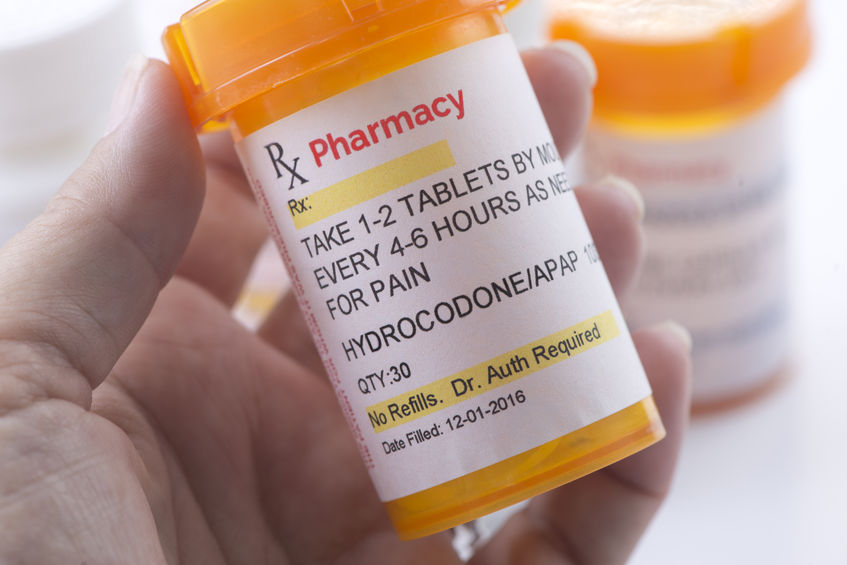Hydrocodone – what ever happened to America’s most popular drug?
For many years, hydrocodone with acetaminophen had been the most popular drug in the US. Always at the head of the ”top drugs” list, it was often reported that there were enough hydrocodone/acetaminophen tablets sold each year to treat everyone in the country for a number of weeks.
Hydrocodone is an opioid drug; it is chemically related to morphine and acts through the same receptors as morphine and other opioids. Interaction with mu (pronounced ‘myoo’) opioid receptors produces pain relief, but can also produce euphoria and/or nausea.

As an opioid drug, hydrocodone is mainly used for pain, but it also has a number of side effects common to the opioids.
The most common adverse effects are sedation, nausea/vomiting and constipation. Opioids slow movement of food through the gastrointestinal tract, producing constipation and contributing to nausea and vomiting in some patients. Opioids suppress the cough center in the brain and are useful as ‘antitussive’ to control coughing. Some opioids also stimulate the vomiting center in the brain. So, we frequently encounter patients who believe they are “allergic” to hydrocodone because of nausea or vomiting or constipation even though this is not actually an allergic mechanism and they might still tolerate other related opioid drugs.
While hydrocodone can interact with opioid receptors on its own, most of its activity comes from its conversion to other more active morphine-related metabolites. Hydrocodone in converted into hydromorphone, a metabolite which has 30 times the opioid receptor activity of hydrocodone. One of the interesting things about this is the variation between individuals in their ability to convert hydrocodone to its more active metabolite.
Hydrocodone is metabolized to the more active hydromorphone by a liver enzyme called CYP2D6 (pronounced ‘sip 2D6’).
The population breaks down into several groups based on the activity of the CYP2D6 enzyme. CYP2D6 activity can be absent, lower than normal or greater than normal in different individuals; activity can be associated with certain ethnic groups, but any of the enzyme activities can be found in any patient.
Patients who lack functional 2D6 activity will not convert hydrocodone to hydromorphone; these are the patients that take hydrocodone with acetaminophen and find that it doesn’t work any better than Tylenol© (acetaminophen). These patients are more likely to be Caucasian, as up to about 25% of Caucasian patients have at least one gene for the enzyme with little or no activity. If you find that hydrocodone preparations don’t work for you, you may be in this group.
Patients with highly active 2D6 enzyme rapidly convert hydrocodone to hydromorphone; this is more common in Ethiopian and Arab populations, but can occur in others as well. These patients may find that the rapid conversion to active metabolite can produce a “buzz” (as well as greater chance of toxicity) and that hydrocodone effects may not last as long as expected. The combination of fast onset and shorter duration might also set these patients up for hydrocodone abuse.
Most patients metabolize hydrocodone normally and find hydrocodone an effective useful drug for relief of moderate to severe pain.
Hydrocodone is also effective as a cough suppressant with or without other active ingredients such as homatropine (a ‘drying’ drug which inhibits secretions) or chlorpheniramine (an older antihistamine which also has ‘drying’ effects and can help patients sleep).
| Brand Names | Contains the drugs … | Used for symptomatic relief of |
| Hycodan™ | hydrocodone | cough |
| Vicodin™, Lortab™, Norco™ | hydrocodone + acetaminophen | pain (moderate to severe) |
| Vicoprofen™ | hydrocodone + ibuprofen | pain (moderate to severe) |
| Hydromet™ | hydrocodone + homatropine | cough |
| Tussicaps™ | hydrocodone + chlorpheniramine | cough and allergy |
The vast majority of patients taking hydrocodone for pain encounter it formulated in combination with acetaminophen (Tylenol™). It is also available in combination with ibuprofen. Combination of hydrocodone with either of these nonprescription pain relievers enhances its pain relief, and ibuprofen provides additional anti-inflammatory activity.
Most patients should be told that they can combine their prescription hydrocodone with additional acetaminophen or ibuprofen within certain limits. In the case of acetaminophen, it is important to remember that acetaminophen is found in many prescription and nonprescription medicines. Patients should take no more than about 3000mg per day of acetaminophen from all sources. Also, drinking alcoholic beverages while taking acetaminophen can set patients up for temporary or sometimes permanent damage to the liver.
Hydrocodone became a schedule II controlled substance on October 6th, 2014. This makes it more difficult for your prescriber to use as prescriptions cannot allow refills in most cases. Time will tell how this influences the long term popularity of the drug.
Hydrocodone can be part of a reasonable treatment plan for moderate to severe pain or for cough.
If you are prescribed hydrocodone, take some time to have your pharmacist check for drug interactions with your other medications. Learn from your pharmacist how to best use hydrocodone in combination with other medications and with other treatments, such as ice or heat, rest and appropriate movement. Take care of yourself.
Resources
NIH PubMed Health
Hydrocodone/Acetaminophen (by mouth)
https://www.ncbi.nlm.nih.gov/books/NBK538530/
Addiction Hope
Hydrocodone Abuse Causes, Statistics, Addiction Signs, Symptoms & Side Effects












